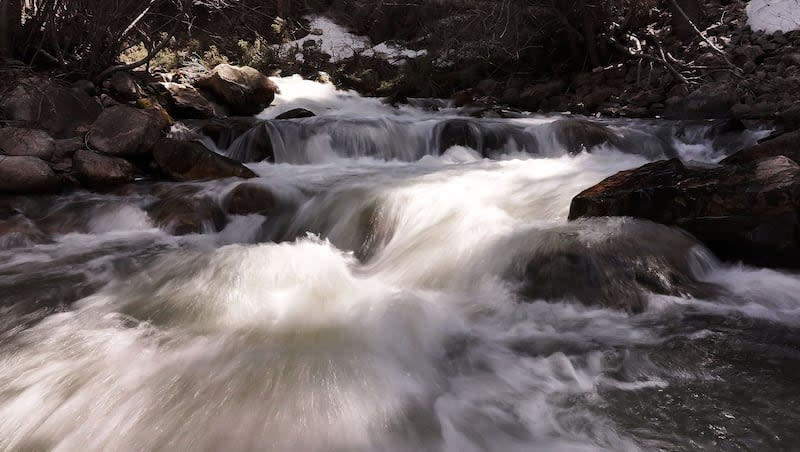Mountain snow, the spring runoff and what to expect

The wet months of January, February and March boosted Utah’s overall snowpack and promise to bring above average runoff to most areas of the state.
It is hard to predict with a firm sense of certainty of what’s to come, officials say, because spring can behave like a temperamental teenager.
“Springtime in Utah is more like a roller coaster than a cruise,” said Glen Merrill, hydrologist with the National Weather Service in Salt Lake City.
Merrill and other water experts met Tuesday in their monthly water supply and forecast meeting to discuss current conditions and what to expect next.
Most reservoirs are expected to fill, and those at a lower capacity like some in the Weber-Ogden Basin are in that situation because they are already making downstream releases to allow room for the coming snowmelt.
The snowmelt is here, with the lower elevation snow coming off quickly.
Across the state, the snow water equivalent, or SWE, sat at 131% of normal as of early April.
Basin conditions include Bear River, 119% of normal; Weber, 133% of normal; Provo, 133% of normal; and southwestern Utah, 108% of normal.
What’s next?
The early part of April started out dry, but then Ogden received an inch of rain in this latest storm that hit Sunday into Monday.
Some observers may call this an unsettled weather pattern, but Merrill and some other experts at the meeting said this is the recipe they hope for in the coming months: a warming up period, followed by cooling down and then repeat.
What they don’t want, he emphasized, is a monstrous storm event packed with rain and snow and then an extended period of days that reach the 90s. With May historically one of the wettest months, there’s reason to believe that slow and steady might be the pace.
So far, the short-term forecasts and longer range outlooks deliver some room for hope and optimism in the coming weeks, but any one outcome is possible, Merrill said.
Gary Henrie, an engineer with the U.S. Bureau of Reclamation, is often asked to use his car analogies to describe current conditions or what to expect.
In this case with weather patterns, the weather is warming up — but not excessively so — much like revving the engine. Then Mother Nature delivers some wet weather and cooler temperatures, and the car slows down to brake going around the curve.
What forecasters, water managers and residents don’t want to see is a full-throttle, pedal to the floor period when it comes to dry, hot conditions that persist. The engine will overheat.
Henrie said last year’s snowpack helped the struggling Lake Powell to come up 44.2 feet. This year, while uncertainty still exists, officials are anticipating a possible rise of 8.6 feet at Lake Powell. It is still not enough to steer the country’s second largest man-made reservoir out of trouble — sitting at 33% of capacity — but every drop helps.
And with reservoirs full and a high runoff expected in rivers and streams, Jordan Clayton said there may be just over a million acre feet of water destined to hit the Great Salt Lake. It is a hopeful prediction, but as with Lake Powell, it will not fill the bucket. Still, it would roughly be 140% of average from April until the end of July.
Clayton, the Utah Snow Survey supervisor with the Natural Resources Conservation Service, said the agency has built a new page on its website dedicated to the Great Salt Lake for those who want to learn more.
Will it flood?
Trevor Grout, with the Colorado River Basin Forecast Center, said in the meeting the streamflow forecasts may seem high, but they were not as high as last year. While it depends on the weather, he emphasized, “Nothing is expected to hit critical threshold.”
Henrie added that water managers have been on top of releases and are keenly tracking streamflow, reservoir levels and the way to hang onto storage capacity while still letting water run downstream and monitoring flooding potential.
“I think we are well placed to deal with these volumes,” Henrie said.
And drought?
According to the U.S. Drought Monitor’s latest evaluation, most of Utah is in not in any drought so far, and only the eastern portions of the state are in abnormally dry conditions or moderate drought. That is not say that Mother Nature might put it in full throttle next year and let the state overheat.

